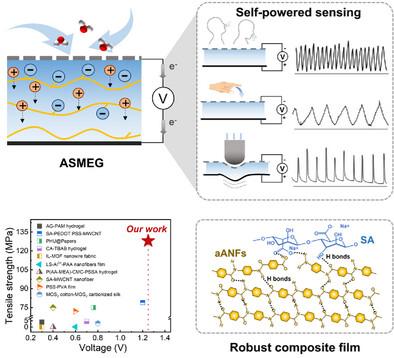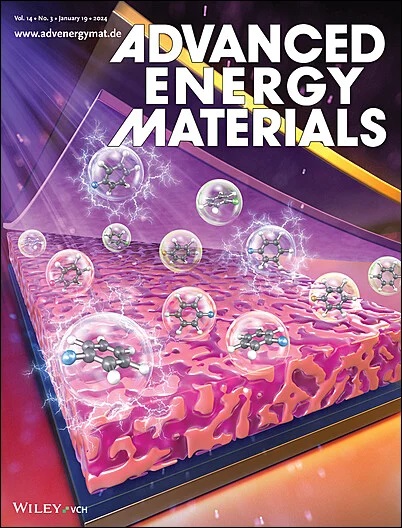Bioinspired Interfacial Design of Robust Aramid Nanofiber Composite Films for High-Performance Moisture-Electric Generators
IF 24.4
1区 材料科学
Q1 CHEMISTRY, PHYSICAL
引用次数: 0
Abstract
The burgeoning field of moisture-electric generators (MEGs) for wearable electronics has garnered significant interest due to their capability to harness energy from atmospheric moisture. Nevertheless, achieving an optimal balance between mechanical resilience and energy generation efficiency in MEGs materials remains a substantial challenge. Herein, the study reports a highly resilient and flexible nanocomposite film comprising activated aramid nanofibers and sodium alginate (aASA), designed via biomimetic methodologies and advanced interfacial activation techniques to enhance power generation efficiency. The aASA film exhibits exceptional mechanical properties, including a toughness of 30.5 MJ m−3, and exhibits superior impact resistance compared to conventional aramid nanofiber films. The asymmetric sandwich-structured MEG fabricated using the aASA film (termed ASMEG) achieves sustained voltage and current output of 1.25 V and 2.52 µA cm−2 over 100 h with minimal degradation at 80% RH, showcasing outstanding performance among existing MEGs. Furthermore, the ASMEG device effectively demonstrates practical utility in self-powered sensing applications, providing structural protection alongside real-time self-monitoring capabilities during dynamic impact scenarios. This work presents an innovative strategy for designing high-performance moisture-electric generation materials specifically tailored for wearable electronics.

求助全文
约1分钟内获得全文
求助全文
来源期刊

Advanced Energy Materials
CHEMISTRY, PHYSICAL-ENERGY & FUELS
CiteScore
41.90
自引率
4.00%
发文量
889
审稿时长
1.4 months
期刊介绍:
Established in 2011, Advanced Energy Materials is an international, interdisciplinary, English-language journal that focuses on materials used in energy harvesting, conversion, and storage. It is regarded as a top-quality journal alongside Advanced Materials, Advanced Functional Materials, and Small.
With a 2022 Impact Factor of 27.8, Advanced Energy Materials is considered a prime source for the best energy-related research. The journal covers a wide range of topics in energy-related research, including organic and inorganic photovoltaics, batteries and supercapacitors, fuel cells, hydrogen generation and storage, thermoelectrics, water splitting and photocatalysis, solar fuels and thermosolar power, magnetocalorics, and piezoelectronics.
The readership of Advanced Energy Materials includes materials scientists, chemists, physicists, and engineers in both academia and industry. The journal is indexed in various databases and collections, such as Advanced Technologies & Aerospace Database, FIZ Karlsruhe, INSPEC (IET), Science Citation Index Expanded, Technology Collection, and Web of Science, among others.
 求助内容:
求助内容: 应助结果提醒方式:
应助结果提醒方式:


